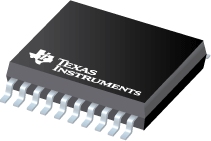Synchronous 1MHz 1.5A Step-Down Voltage Regulator 20-HTSSOP -40 to 125
PDF, 178 Kb, Revision: A, File published: Apr 23, 2013
Of all the voltage regulator control strategies ever devised, the hysteretic regulator is probably about thesimplest. This control methodology simply turns a switch on when the output voltage is below a referenceand turns the switch off when the output rises to a slightly higher reference. The output ripple is thereforea direct function of the difference between the upper and lower reference
PDF, 558 Kb, Revision: B, File published: Apr 23, 2013
This application report provides design information to help select an off-the-shelf inductor for anycontinuous-mode buck converter application.
PDF, 1.4 Mb, Revision: A, File published: Apr 23, 2013
This application note provides thermal power analysis techniques for analyzing the power IC.
PDF, 9.2 Mb, Revision: B, File published: Apr 23, 2013
This thermal application report provides guidelines for the optimal board layout to achieve the best thermalresistance for exposed packages. The thermal resistance between junction-to-ambient (ОёJA) is highlydependent on the PCB (Printed Circuit Board) design factors. This becomes more critical for packageshaving very low thermal resistance between junction-to-case such as exposed pad TSSOP
PDF, 3.6 Mb, Revision: A, File published: Apr 23, 2013
This application note will explore how the layout of your DC/DC power supply can significantly affect theamount of EMI that it produces. It will discuss several variations of a layout analyze the results andprovide answers to some common EMI questions such whether or not to use a shielded inductor.
PDF, 82 Kb, Revision: C, File published: Apr 23, 2013
When designing a high frequency switching regulated power supply layout is very important. Using agood layout can solve many problems associated with these types of supplies. The problems due to a badlayout are often seen at high current levels and are usually more obvious at large input to output voltagedifferentials. Some of the main problems are loss of regulation at high output current
PDF, 2.5 Mb, Revision: C, File published: Apr 24, 2013
Electromagnetic Interference (EMI) is an unwanted effect between two electrical systems as a result ofeither electromagnetic radiation or electromagnetic conduction. EMI is the major adverse effect caused bythe application of switch-mode power supplies (SMPS). In switching power supplies EMI noise isunavoidable due to the switching actions of the semiconductor devices and resulting disconti
PDF, 374 Kb, Revision: C, File published: Apr 23, 2013
This application report provides SIMPLE SWITCHER™ PCB layout guidelines.
PDF, 219 Kb, File published: Sep 19, 2005
PDF, 201 Kb, Revision: C, File published: Apr 19, 2016
PDF, 2.7 Mb, Revision: A, File published: Apr 23, 2013
This application report shows how to measure the critical points of a bode plot with only an audiogenerator (or simple signal generator) and an oscilloscope. The method is explained in an easy to followstep-by-step manner so that a power supply designer can start performing these measurements in a shortamount of time.
PDF, 742 Kb, Revision: B, File published: May 3, 2004
Application Note 643 EMI/RFI Board Design
